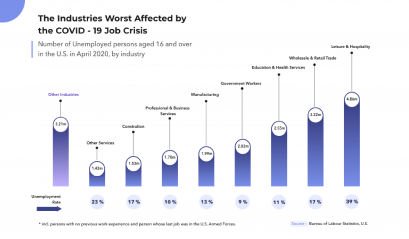- The COVID-19 outbreak has accelerated the need for robust talent management solutions for business continuity and optimized growth across organizations
- ‘Internal Mobility’ has emerged as a strategy in response to contracting recruitment budgets and a reduced workforce
- Companies with a robust internal mobility program can re-organize employees and skillsets from low to critical priority jobs
- With the right internal mobility solutions, organizations can offer L&D programs to employees that lack the proficiency required to excel in certain roles
’Companies are not really hierarchies, they’re networks’– Josh Bersin
As the world comes to terms with the COVID-19 outbreak and the ‘new reality’ of business and home life, corporations worldwide have had to explore preventive and sustainable measures that can be rapidly translated into actions. HR, Strategy, Finance and other core functions of organizations, confronted with unprecedented challenges, have had to ensure business continuity while managing and prioritizing talent requirements. Executives at the helm have had to quickly identify employee groups, activities and job roles critical to operations while determining the potential opportunities for those with less work to do. In the past few months, organizations with the foresight to take bold and realistic decisions have emerged as strong leaders. These companies, Unilever being one example, have successfully anticipated drivers of business continuity to recognize and retain top talent and optimize resources for the long-term when markets recover. And the one solution that has increasingly emerged as central to managing resources is ‘Internal mobility’.
82% of organizations anticipate a decline in external hiring in the next 3 months. – HRD Magazine
With hiring freezes in most companies, we are seeing a contraction of recruitment budgets coupled with a reduced workforce due to the pandemic. What route must organizations and HR leaders take to ensure skill sets and roles critical for essential operations in a dynamic market are fulfilled by the right people and in time? How do companies ensure that the competencies vital for growth are harnessed as consumer behaviors and markets continuously shift? According to this poll – 82% of organizations anticipate a decline in external hiring in the next 3 months. This reinforces the argument for companies to look inwards and re-examine their talent acquisition, management, learning and development systems by considering the skill shortages that have become increasingly evident in the last few years. As per Deloitte, ‘3 out of 4 of the leading talent acquisition teams’, build and leverage their internal talent pools ‘compared with roughly one in 10 low-performing teams’.
Organizations with clear internal mobility objectives have designed programs and systems that fuel the following components:
Comprehensive and continuous talent assessment:
The job market landscape has witnessed a massive spike in the number of lay-offs and furloughs across sectors and geographies. While it is a reasonable outcome under a global economic slowdown, it is not the only measure to combat market shifts. Strong internal mobility platforms powered by the right technological levers have successfully afforded companies a broader and detailed picture of their talent. A comprehensive and regularly updated view of the current workforce capabilities, their linkages to essential business roles and operations, and their synergies with related skillsets help to address talent assessment and development gaps for newer and more flexible job roles. Internal mobility within organizations clarifies employee-groups that have been adding value prior to the pandemic and have been able to build cross-functional capabilities. These insights allow companies to (Unilever, Schneider, Cisco, for instance) undertake the necessary redeployment and redistribution of employees from low-priority groups to critical and high-potential job zones to ensure business continuity and growth. This skills to talent to job fit at the right time perpetuates talent agility and forms the cornerstone of a good internal mobility framework.
Targeted focus on skill-evaluation, skills forecasting, reskilling and upskilling:
‘44% of respondents say organizations will face skill gaps within the next 5 years, while 43% report existing skill gaps’ – Mckinsey Survey
Lessons emerging from the pandemic indicate an organizational need to focus on the depth and scope of organizational skill pools and the strength of skills forecasting models as opposed to primarily focusing on isolated job positions. Recognizing the right skills and competency mix within the company unlocks synergies across job roles and functions allowing employees to build their cross-functional knowledge. Intuitive internal mobility tools clarify connections within organizational skills to determine competency gaps corresponding to the must-have skills for newer and more challenging roles. Companies can rely on such insights to strengthen their internal talent pipelines with the flexibility to address the demands of new job roles and evolving demands.
Reskilling (preparing employees for newer roles), upskilling (maximizing the potential of employees on current and vital roles), and cross-training models are gaining prominence in HR decisions as organizations actively indulge in job redesigning. By arming their personnel with the right skills, organizations can safeguard their strategic interests. Therefore, internal mobility is key to business decision making. Furthermore, it is a proven medium for engaging and retaining top talent during periods of transition and operational lull. Conversely, with the right internal mobility solutions, organizations can capitalize on these times to offer learning and development programs to other employees who assume vital positions, have related experience but lack the proficiency and knowledge-depth required to excel in those roles.
Digital and collaborative learning platforms:
Internal mobility of employees redefines talent engagement and retention and extends them beyond static hierarchical structures.
With remote work replacing traditional modes of working, organizations, HR, and learning teams along with employees have had to acclimatize to new learning management systems (LMS) and knowledge-sharing avenues to deliver business goals. This change compels leaders to explore more user-friendly, intuitive, and insightful learning platforms for businesses that allow for wider knowledge-transfer and foster competency building. Learning and training avenues with on-the-job development measures such as stretch assignments, rotational projects, leadership challenges as well as online learning and training material for preferred job roles can provide opportunities for ambitious employees seeking new meaning in their work. In fact, lateral moves and stretch assignments have been seen to increase engagement by 30%. Organizations stand to gain through learning development mechanisms simply because they lead to tangible skills expansion and therefore talent agility, not to mention a steady line of competent leaders that can address all succession planning needs.
Internal talent mobility aims to find talent solutions that lie at the cusp of skill groups, job demands, and workforce planning in response to evolving market conditions.






